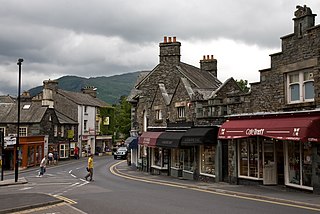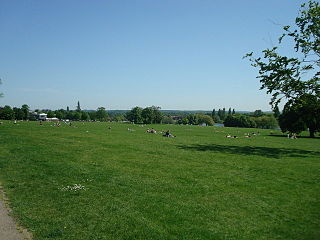
Cumbria is a ceremonial county in North West England. It borders the Scottish council areas of Dumfries and Galloway and Scottish Borders to the north, Northumberland and County Durham to the east, North Yorkshire to the south-east, Lancashire to the south, and the Irish Sea to the west. Its largest settlement is the city of Carlisle.

The Lake District, also known as the Lakes or Lakeland, is a mountainous region and national park in Cumbria, North West England. It is famous for its landscape, including its lakes, coast, and the Cumbrian mountains; and for its literary associations with Beatrix Potter, John Ruskin, and the Lake Poets.

Temple Newsam, is a Tudor-Jacobean house in Leeds, West Yorkshire, England, with grounds landscaped by Capability Brown. The house is a Grade I listed building, one of nine Leeds Museums and Galleries sites and part of the research group, Yorkshire Country House Partnership.

Ambleside is a town and former civil parish in the Westmorland and Furness district of Cumbria, England. Within the boundaries of the historic county of Westmorland and located in the Lake District National Park, the town sits at the head of Windermere, England's largest natural lake. In 2020 it had an estimated population of 2596.

Windermere is a ribbon lake in Cumbria, England, and part of the Lake District. It is the largest lake in England by length, area, and volume, but considerably smaller than the largest Scottish lochs and Northern Irish loughs.

Stourhead is a 1,072-hectare (2,650-acre) estate at the source of the River Stour in the southwest of the English county of Wiltshire, extending into Somerset. The estate is about 4 km northwest of the town of Mere and includes a Grade I listed 18th-century Neo-Palladian mansion, the village of Stourton, one of the most famous gardens in the English landscape garden style, farmland, and woodland. Stourhead has been part-owned by the National Trust since 1946.

Wimpole Estate is a large estate containing Wimpole Hall, a country house located within the civil parish of Wimpole, Cambridgeshire, England, about 8+1⁄2 miles southwest of Cambridge. The house, begun in 1640, and its 3,000 acres (12 km2) of parkland and farmland are owned by the National Trust. The estate is regularly open to the public and received over 335,000 visitors in 2019. Wimpole is the largest house in Cambridgeshire.

Bowness-on-Windermere is a town and former civil parish, now in the parish of Windermere and Bowness, in the Westmorland and Furness district, in the ceremonial county of Cumbria, England. It lies next to Windermere lake and the town of Windermere to the north east and within the Lake District National Park. The town was historically part of the county of Westmorland and it also forms an urban area with Windermere. The town had a population of 3,814 in the 2011 Census.

Danson Park is a public park in the London Borough of Bexley, South East London, located between Welling and Bexleyheath. At 75 hectares, it is the second largest public park in the borough, and the most used by the community. Opened in 1925, it is often considered the finest green open space in the borough, and is Grade II listed on the Register of Historic Parks and Gardens. The park also gives its name to the electoral ward that covers the park and the surrounding area. The park is located at grid reference TQ472752. The southern boundary of both the park and the ward is delineated by Rochester Way, the A2 road.

Roundhay Park in Leeds, West Yorkshire, England, is one of the biggest city parks in Europe. It covers more than 700 acres (2.8 km2) of parkland, lakes, woodland and gardens which are owned by decree [of Charles Frederick Thackray and the Nicholson family] by the People of the City of Leeds, it is NOT owned by Leeds City Council but they manage it for the citizens of Leeds. The park is one of the most popular attractions in Leeds; nearly a million people visit each year. It is situated on the north-east edge of the city, bordered by the suburb of Roundhay to the west, Oakwood to the south and the A6120 outer ring road to the north.

Eastville Park is an urban park in Bristol, England. The grounds that became the park were purchased from Greville Smyth of Ashton Court and the boundary walls are listed with Historic England. The facilities include a lake and tennis courts.
Cartmel Peninsula is a peninsula in Cumbria in England. It juts in a southerly direction into Morecambe Bay, bordered by the estuaries of the River Leven to the west and the River Winster to the east. It is, along with the Furness Peninsula, one of the two areas of that formed Lancashire North of the Sands, and the better known 'Furness' is often used to describe both peninsulae together. To its north, the peninsula's borders are usually given as the banks of Windermere and the border with the historic county of Westmorland between the Lake and the head of the Winster.

Albert Park is an open access, free public park, located in Middlesbrough, in the borough of Middlesbrough and the ceremonial county of North Yorkshire, England.

Storrs Hall is a hotel on the banks of Windermere in Storrs in the Lake District, Cumbria, England. The hotel, a Grade II* listed Georgian mansion, is also home to the National Trust-owned folly the "Temple" on the end of a stone jetty on Windermere. Situated in the Lake District, Storrs Hall sits alongside the Windermere.

Lakeside railway station is on the heritage Lakeside and Haverthwaite Railway in England. It was previously the terminus of the Furness Railway Ulverston to Lakeside Line, which was closed as part of the Beeching Axe in 1965. It serves the village of Lakeside in Cumbria, as well as the tourist attractions located there.

Hanley Park is an urban park in Stoke-on-Trent, England. Officially opened on 20 June 1897, it occupies about 63 acres (25 ha) of land. The park was developed by the town of Hanley over a period of five years and cost approximately £70,000. It has been described as a good example of a late Victorian municipal park, and is listed Grade II* in Historic England's Register of Parks and Gardens.

Staveley-in-Cartmel is a small village and civil parish in South Lakeland district, Cumbria, England. It lies east of Newby Bridge, near the south end of Windermere, 9 miles (14 km) northeast of Ulverston. It is sometimes known as Staveley-in-Furness. Both names distinguish it from another Staveley in Cumbria. In the 2001 census the parish had a population of 428, decreasing at the 2011 census to 405.
Colonel George John Miller Ridehalgh (1835-1892) was a director of the North Lonsdale Iron and Steel Company, colonel of the 2nd Westmorland Volunteer Battalion Border Regiment] and one of the founder members of the Royal Windermere Yacht Club. He lived at Fell Foot Park in Staveley-in-Cartmel, Cumbria, England, where the gothic boat-houses he built still exist and are Grade II listed buildings, although the house was demolished in 1907.
Staveley-in-Cartmel is a civil parish in the South Lakeland District of Cumbria, England. It contains 22 listed buildings that are recorded in the National Heritage List for England. Of these, one is listed at Grade II*, the middle of the three grades, and the others are at Grade II, the lowest grade. The parish is in the Lake District National Park. It contains the villages of Staveley-in-Cartmel and Newby Bridge, and smaller settlements, but is mainly rural. In the parish is Fell Foot Park, a country park on the shore of Windermere; four buildings in this park have been listed. The other listed buildings include farmhouses, farm buildings, other houses, a milestone, a bridge, a church, and a sundial in the churchyard.
Windermere and Bowness is a civil parish in the Westmorland and Furness District of Cumbria, England. It contains 82 listed buildings that are recorded in the National Heritage List for England. Of these, four are listed at Grade I, the highest of the three grades, twelve are at Grade II*, the middle grade, and the others are at Grade II, the lowest grade. The parish is in the Lake District National Park and lies to the east of Lake Windermere. It contains the towns of Windermere and Bowness-on-Windermere, the village of Troutbeck Bridge, and the surrounding countryside. Most of the older listed buildings are farmhouses and farm buildings, and later listed buildings include large houses and associated structures, one of the houses being on an island in the lake. The other listed buildings include churches and items in churchyards, public houses and hotels, bridges, a drinking fountain, and boathouses.




















